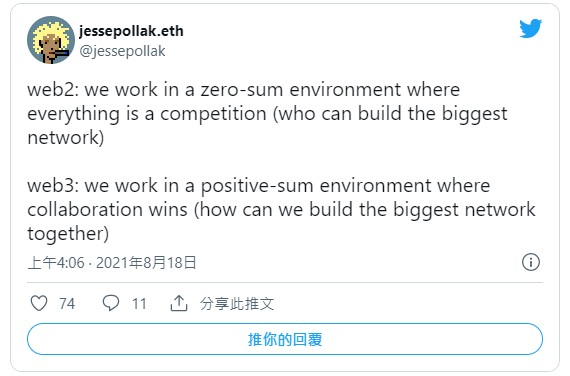
▲圖片來源:Orbon Alija/Getty Images
Web 1.0 was the static web, and Web 2.0 is the social web, but Web 3.0 will be the decentralized web. It will move us from a world in which communities contribute but don’t own or profit, to one where they can through collaboration.
By breaking away from traditional business models centered around benefiting large corporations, Web3 brings the possibility of community-centered economies of scale. This collaborative spirit and its associated incentive mechanisms are attracting some of the most talented and ambitious developers today, unlocking projects that were previously not possible.
Web3, as Ki Chong Tran once said, is “The next major iteration of the internet, which promises to wrest control from the centralized corporations that today dominate the web.” Web3-enabled collaboration is made possible by decentralized networks that no single entity controls.
In closed-source business models, users trust a business to manage funds and execute services. With open source projects, users trust the technology to perform these tasks. In Web2, the bigger network wins. In Web3, whoever builds the biggest network together wins.

In a decentralized world, not only is participation open to all, the incentive structure is designed so that the greater the number of participants, the more everybody succeeds.
Learning from Linux
Linux, which is behind a majority of Web2’s websites, changed the paradigm for how the internet was developed and provides a clear example of how collaborative processes can drive the future of technology. Linux wasn’t developed by an incumbent tech giant, but by a group of volunteer programmers who used networked collaboration, which is when people freely share information without central control.
In “The Cathedral & The Bazaar,” author Eric S. Raymond shares his observations of the Linux kernel development process and his experiences managing open source projects. Raymond depicts a time when the popular mindset was to develop complex operating systems carefully coordinated by a small, exclusionary group of people — “cathedrals,” which are corporations and financial institutions.
Linux evolved in a completely different way. Raymond explains, “Quality was maintained not by rigid standards or autocracy, but by the naively simple strategy of releasing every week and getting feedback from hundreds of users within days, creating a sort of Darwinian selection on the mutations introduced by developers. To the amazement of almost everyone, this worked quite well.” This Linux development model, or “bazaar” model as Raymond puts it, assumes that “bugs are generally shallow phenomena” when exposed to an army of hackers without significant coordination.
詳文見 : techcrunch
若喜歡本文,請關注我們的臉書 Please Like our Facebook Page: Big Data In Finance


留下你的回應
以訪客張貼回應